
December 2014
The Primm Story
By Paul Harvey
In October, I chose to write about two of the museum's unique engines; the Swan and the Lima. "The Swan Story" was published in October followed by "The Lima Story" in November. As I scanned more and more pages from Newspapers.com and Ancestry.com, as well as the internet, I found that there was a third story that begged to be written to complete this trilogy. The concluding story was John Primm and his oil engine; and that picked up where Lima ended. The evolution of these companies and all their successors finally ended with Primm. There were successes and failures, many business transfers, and countless other problems that started in 1900 with Swan and finally ended in 1935 with Primm. And so our concluding story of this fascinating tale unfolds---
John Matthew Primm was born at Clarksburg, West Virginia, on May 18, 1870, as noted in the U.S. Census of that year. His father, John D. Primm, was a carpenter from Virginia, and his mother, Martha, was a full-time housewife. They had settled in Clarksburg, West Virginia, to raise their family. John, the youngest of seven children, had a mechanical inclination but little formal education. He married Hattie in 1898, but there were no children. According to the census records, he was living with his wife in Marietta, Ohio, in 1900 and moved to Vanburen, Indiana, sometime before 1910 where he is registered at that date. Moving to Lima, Ohio, he made a trip to Cuba about 1916 to promote his oil engine for use in the sugar cane mills, as revealed by the U.S. Passport Records. The U.S. Census of 1920 notes that he and Hattie were then living in Marion, Ohio, and he was a plant manager. Surprisingly, no other records are found until The California Death Index lists his passing on July 17, 1941, in Los Angeles.
Primm was granted five patents during his lifetime, and all except one dealt with his engine directly. Photo 1 is his first patent and the only one he obtained while in Vanburen, Indiana. U.S. Patent number 956,169 was issued on April 26, 1910, and assigned to the Primm Oil Engine Company of Vanburen. The engine was designed to be a moderate compression, direct injection, two-cycle type that required an external heating torch to start. These are sometimes referred to as "semi-diesels." Once started, the engine produced enough heat to continue its operation. To ensure this would happen, his patent showed a steel plate cast into arms extending from the center of the piston. The fuel oil injector, in the head, sprayed directly onto this plate so that in operation, the plate became red hot, and assured complete combustion, even with heavier grades of crude oil. The extending plate prevented the piston from becoming excessively hot. His idea was successful and so, his business was launched.
The remaining four patents were issued to Primm when he was in Lima, Ohio. This era of his career, about 1913 to 1918, appears to have been a time of refinement of his engine. His next patent, number 1,057,270, issued March 25, 1913, concerns a pitman arm bearing adjustment that could have been used on the engine's connecting rod, although this use is not mentioned in the patent text. It was assigned to The Power Manufacturing Company of Lima, Ohio, as are the remainder of his patents. Hence, the name of the company changed with the move to Lima. Patents 1,057,271 of March 25, 1913, and 1,090,500 of March 17, 1914, concerned refinements of the engine governor. Finally, patent 1,150,225 of August 17, 1915, illustrated in Photo 2, encompassed the complete engine and detailed its operation. At last, John Primm had a very successful machine and proceeded to secure a place to manufacture it and promote the necessary marketing.
The first mention of John Primm's career was found in the Huntington Herald (Indiana) issue of March 24, 1906. He was listed as being employed by the Warren Machine Company. Warren, Indiana, was only a couple of miles from Vanburen, Indiana, where he resided. Three years later, the Indianapolis News, December 6, 1909, noted that the Primm Oil Engine Company of Vanburen had been incorporated with a capital stock of $40,000.00, and that J. M. Primm was a director. This would be the first location of his oil engine production. This venture was short-lived as noted by the Indianapolis Star issue of October 29, 1911. Three lines said it all and to summarize; the Primm Oil Engine Company of Vanburen has been dissolved. It is assumed that Vanburen's small size, merely a village, and its remote location, was the cause of the move.
At the same time, the Lima News carried a big article entitled, "NEW INDUSTRY WITH FUTURE." It details that a new organization, The Power Manufacturing Company, has purchased the old Swan plant on the corner of Greenlawn Avenue and C & E Railway. Mr. Primm was named vice president, and the new firm had completely remodeled the facility and moved the machinery from Vanburen into it, as well as adding much new equipment. They advertised that they would manufacture crude oil engines, gas and gasoline engines, and a general line of oil field equipment. Desiring a fresh, new start, the firm stated that no one connected with the old companies would be identified with the new concern. They now had a new name, a new location, and a successful product to market.
The Lima works of The Power Manufacturing Company prospered until May 13, 1916, when a huge fire leveled the foundry. Noted in the Lima News of that date, President Primm stated that there would be no lay-offs, and work would resume in the open air. Fifty six men were employed at the foundry. Following closely, the Lima News of May 15, 1916 states that President Primm is considering an offer from another city for relocation of the plant. Hence, the end of the old factory, used only five years, looms in the near future.
The move did happen and the new location was Marion, Ohio. A city with much industry and transportation, Marion offered a free location and the money to make the move. Unable to resist, The Power Manufacturing Company was incorporated in Marion, Ohio, for $1,000,000, a huge amount for that time, on September 18, 1916, as noted in the Cincinnati Enquirer. This would be the largest facility in the world devoted to the exclusive manufacture of the semi-diesel, crude oil burning engine! The main machine shop would be 500 feet long and 60 feet wide, with a "mammoth" foundry next door. Photo 3 shows a sketch of the big facility as taken from the Marion Star. This was now big business with markets in the south for cotton gins, in the east for power plants and factories, and in the west for gold and silver mines. World markets were being established and the engine was well accepted.
The Marion Star of April 12, 1919 ran an article about the success of The Power Manufacturing Company there. It states the annual payroll was $250,000, and the "famous" oil engines were being shipped all over the world. Agencies have been established in most states and many foreign countries. The size of the plant has been doubled to keep up with demand. Engines of 150 hp, single-cylinder, and 300 hp, twin-cylinder were built, with the smallest being 8 hp.
An interesting note from the Marion Star of September 2, 1919 is that The Power Manufacturing Company will start producing the Hinds Coin Sorting Machines. These interesting devices were able to, mechanically, quickly sort and count coins dumped into them. Years ago, they were common on bank counters and desks. They foresaw a market in banks, street railways, stores, and other locations where fast coin sorting is needed. George N. Hinds lives in Marion and has made an agreement with John M. Primm to manufacture his machines. No further information has been found.
Photo 4, taken from the Cincinnati Enquirer issue of June 2, 1920 is an advertisement from Primm's "glory" years of prosperity. It is typical of so many of their advertisements of the time.
As with any empire there is an end, and that did happen
with Primm. Three factors became the cause: the depression of the
1930s; the design was not updated or modernized; and John Primm was
growing older. The Marion Star of 1929 notes that Osgood
Manufacturing of Marion acquired The Power Manufacturing Company. Osgood
was noted for making power shovels and construction equipment. The Star
does note that Primm sponsored a baseball team in 1931. The business
continued to decline and the Marion Star, September 18, 1936, mentions
that Defiance Pressed Steel Company took over the old Power
Manufacturing Company plant and intends to
modernize it. They intend
to pre-form steel parts for use in industry. There is no definite date
on Primm's end, but 1935 would be a reasonable guess. The Star
mentions that Marion Metal Products bought the plant in 1941, the year
of John Primm's death. The trilogy has ended!
With John Primm as a memory, we will now move ahead 75 years to discover the museum's Primm engine. It resides in the Power Tech Annex building, patiently awaiting the joy of running again. There is much oil engine work going on there and it is on the schedule soon. Photo 5 shows the engine and its location in the Annex. Already skidded, it will come to life soon. This is a 45 hp Primm, made in Marion, Ohio, and served in a small factory near Cleveland, Ohio. Note the original olive green paint that still remains. It was purchased from another collector who was able to save it from being scrapped and has been here many years. Although not on the engine, the museum does have the massive clutch pulley and outboard bearing.
Photo 6 is a detail of the head end of the engine. The automatic air starting device is located on the left side of the head and operates from a cam on the crank shaft. Note the linkage across the back of the cylinder to a handle that enables the operator to engage it from the right side of the engine, where all the other controls are located. This is better shown in Photo 9. The fuel oil injector is located in the center of the head, and equipped with a "pre-warming" device. An electric "glow plug" device is mounted on the top of the head and has battery connections. It provides the heat needed for starting.
The operator's side of the cylinder is shown in Photo 7. The power operated, mechanical lubricator is seen at the mid-section of the engine. The cylinder is flange mounted to a very massive main frame that is able to withstand the pressures of the oil engine cylinder explosions when running at full load. The main frame houses the cross head slider which connects the piston rod to the connecting rod, that extends on to the crankshaft. Photo 8 shows the fuel pump and governor linkage detail. It is well done and easy to adjust. Note the graceful arched casting for its mounting. The priming and shut off lever is seen in the center of the photo.
The water injector, controlled by the governor, injects a small amount of water to "cushion" the explosions in the cylinder. The harder the engine works, the more water is injected. The governor controls both the amount of water and fuel injected, according to the load demand. This is seen in Photo 9. Note the air start control handle to the extreme right of the photo and the glow plug to the left. The small name plate is noted in the center of the cylinder and is detailed in Photo 10. The rear view of the engine is shown in Photo 11. It details the cast iron crank case cover and large governor head. It is interesting to note that this engine has an enclosed vertical governor, when Primm's patents referred to a crankshaft governor. Regardless, this gives this engine a very handsome appearance. Photo 12 reveals the rear plate of the engine and the "trademark" Primm insignia. Fortunately, many Primm engines have been saved. They remind us of the magnificent engines of The Power Manufacturing Company of years gone by. And thus the Primm story - and the trilogy - closes.

Photo 1: Primm patent for a crude oil engine

Photo 2: Primm patent for an internal combustion engine

Photo 3: Primm factory in Marion, Ohio
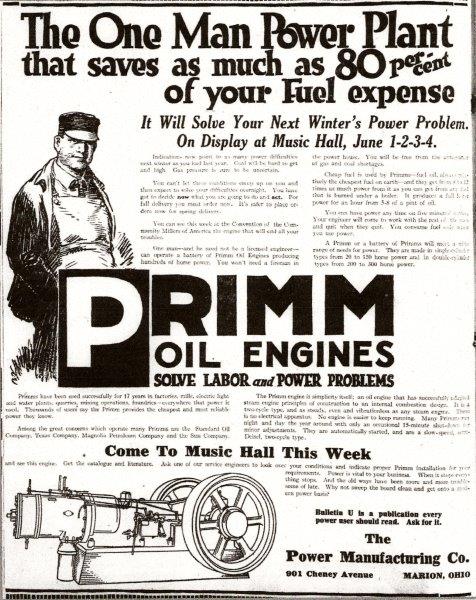
Photo 4: Advertisement for Primm oil engines
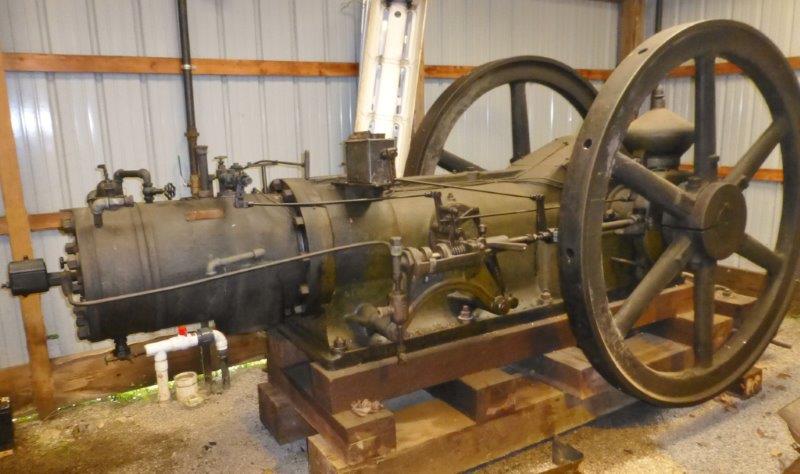
Photo 5: Primm 45 hp engine at the museum
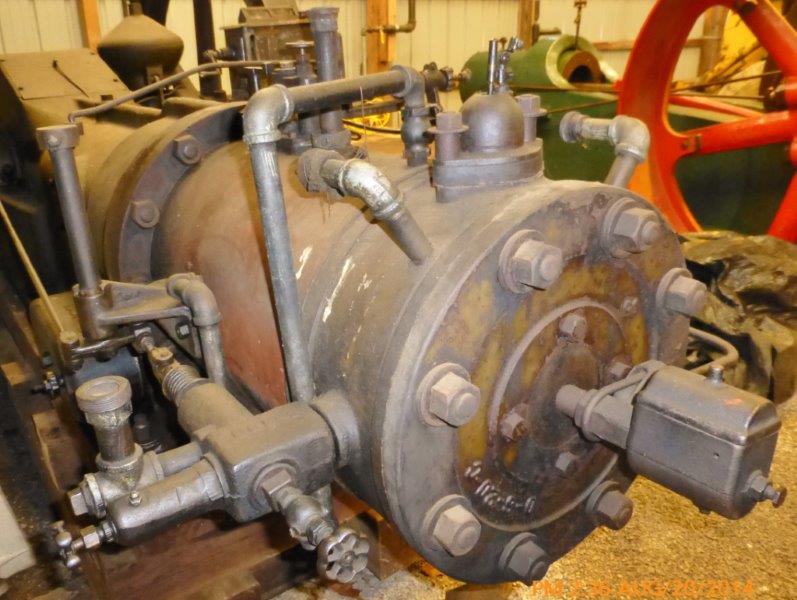
Photo 6: Air starting device on the Primm
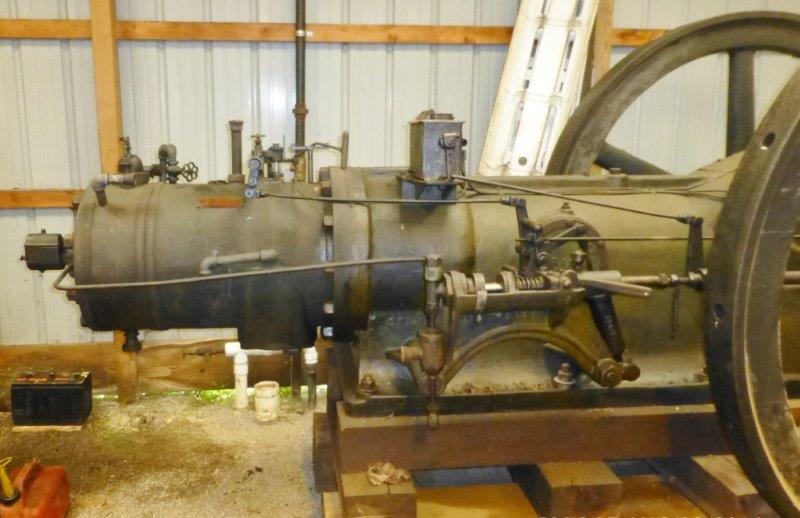
Photo 7: Detail of the Primm cylinder
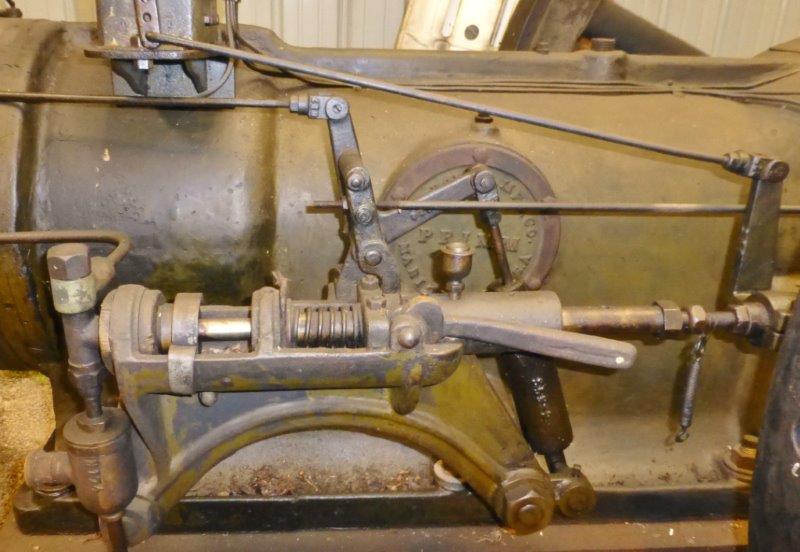
Photo 8: Fuel pump and governor linkage
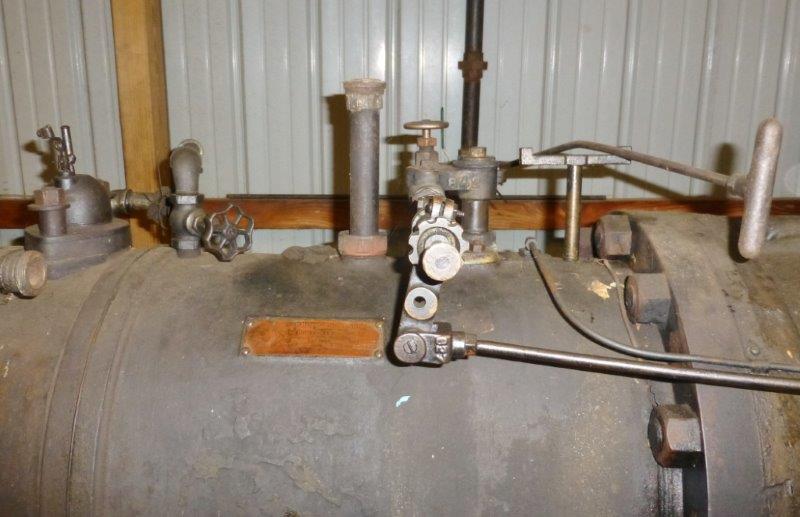
Photo 9: Water injector and actuator linkage
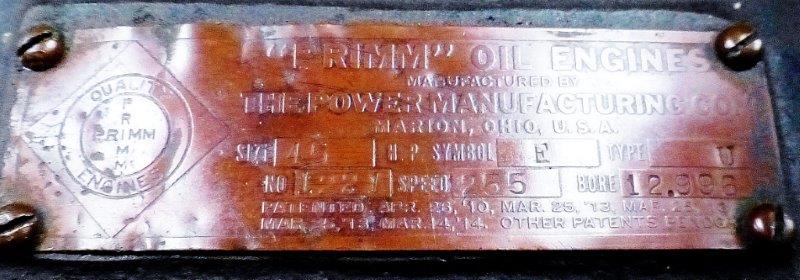
Photo 10: Primm engine nameplate
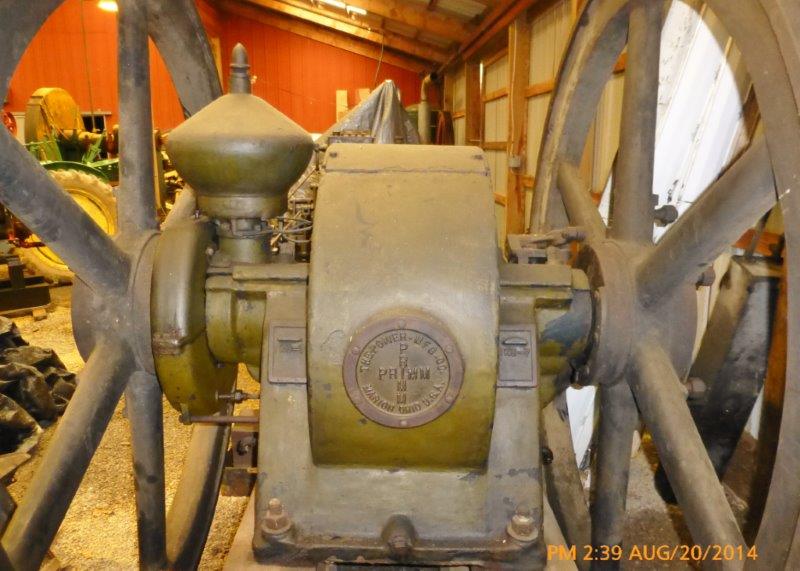
Photo 11: Enclosed vertical governor
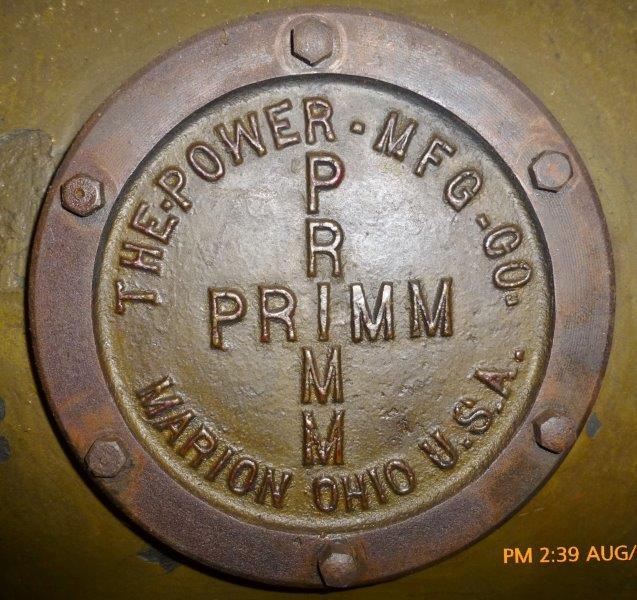
Photo 12: Rear cover plate for the Primm engine